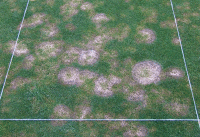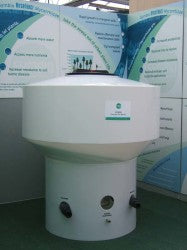Grass Nutrition for Early Spring Growth

How can you provide a good playing surface and manage the uneveness caused by perennial grasses growing earlier than poa annua, the more rapid growth around aeration holes and the patches left by winter disease and surface damage?
It may help to overcome the problems if we understand what causes them.
Obviously the soil and air temperature has to be over a certain level which will differ with the various combinations of rootzone and grass species but there are a number of factors that can be manipulated to produce results.
The perennial problem for turf managers is that fescue, bent or rye grasses start to grow before poa annua. This is a new area of research and I am sure there is much to be discovered but there seem to be a number of reasons why this is so. Perennial grasses have a much more complex soil food web of fungi, bacteria, protozoa and nematodes because they put their effort into growing and surviving as perennial plants. Conversely in spring poa annua puts it effort into seeding then it dies so it does not need the complex relationships with soil fungi and mycorrhizae that provide the plant with nutrient.
Everybody that has experienced snow mould this winter or noticed that it is moulds and fungi that degrade food in the fridge have witnessed that some fungi are active at lower temperatures of 2-3oC than bacteria which mostly become active above 5-60C i.e. refrigerator temperature. It appears that the fungal food web that supports perennial grass becomes active in cooler temperatures than the bacterial dominant food web that supports poa annua. Thus the finer perennial grasses may get a supply of nutrient for earlier growth.

High inputs of inorganic fertilisers in early spring leads to a cycle of boom and bust in grass growth and the threat of disease throughout the year. Fortunately a range of immediately available organic nutrients are now available together with the biostimulants that make them work.
Poa annua does not have the natural resources to take up nitrogen and phosphate in cool conditions so nutrient must be introduced into the plant.
The grass plant takes up most of its nitrogen in the form of nitrate. To convert ammonium to nitrate requires oxygen and biological activity. All too often oxygen is lacking because the rootzone is compacted, waterlogged or both giving rise to the tufts of grass around tine holes. Applying ammonium sulphate when oxygen is not available will not work. There are two remedies to this problem. Nitrogen can be supplied as nitrate in the form of calcium, magnesium or potassium nitrate, if applied as liquid you will not get spotting from the fertiliser.
If close tinning or other aeration is not possible oxygen can be released evenly into the rootzone by spraying the new family of products that act as a catalyst for oxidation like Symbio's Liquid Aeration.
When soil temperatures are low most of the nitrate is taken into the plant through the cell walls, this effect can be enhanced by mixing the nitrate fertiliser with a good chelating agent. The best cool season chelator is Fulvic Acid which also has the benefit of being a good biostimulant that encourages growth in low light conditions and helps thicken the cell walls of the plant.
The soil microbiology that makes nutrients available for growth can also be stimulated. As a general rule of thumb bacterial activity doubles for every 10oC rise in temperature from about 5oC to 35-40oC. So you will get some bacterial activity when soil temperatures reach 5-60C. If you have frost free nights this temperature can be achieved to sufficient soil depth for growth in many well drained soils when air temperatures are as low as 100C for a few days. When bacterial activity starts you can stimulate the soil microbiology, though care must be taken if you have active fusarium as you will probably just stimulate the fusarium.
Biostimulants are commonly lumped together but in fact they work differently and should be used for different purposes. The Pitchcare message board has frequent posts confirming that applying molasses in spring encourages growth. Molasses is a readily available form of carbohydrate and simple sugars and is an excellent stimulant for soil bacteria, so applying molasses will help the food web that supports poa annua and will help retain any nutrients exuded from the root system of the plant. Readily available carbohydrate will also stimulate the growth of mycorrhizal fungi which are essential for the uptake of phosphate into the plant.
Fulvic acid is the best stimulant for cool season growth because of its properties as a chelating agent and nutrient it is now available in fairly concentrated form e.g. Symbio Fulvic Booster but is usually available in a mix with humic acid which is also a readily available fungal biostimulant. At the very start of the growing season fulvic acid and fish hydrolysate are the preferred biostimulants.
Fish hydrolysate also has the advantage of containing readily available phosphate and potassium which can be taken into the plant via the foliage or via the root. To encourage early growth, adsorption of soluble phosphate is very important because phosphate is not readily available in soluble form in most soils, granular phosphate fertiliser take time to break down and become available and the mycorrhizal fungi that produce enzymes to solubilise phosphate and make it available for growth are not that active in cool soils. Fish hydrolysate ticks all the boxes in providing a biostimulant for bacterial and fungal growth and easily absorbable soluble phosphate.

Liquid seaweeds while an excellent source of trace elements and food sources for bacteria and fungi require the higher level of biological activity which comes with warmer soils so they have a much greater impact on plant growth and vigour when the soil temperatures are capable of supporting strong growth.
A further reason for slow growth in spring is the lack of sunlight for photosynthesis which is more of a problem in the south of the UK when soil temperatures can support growth in March though daylight hours are still low limiting sunlight for photosynthesis. While fulvic acid has been shown to help with low light growth in spring, and in stadium conditions year round, grass in the shade will invariably be slower to start than grass open to sunlight. Sadly the best solution to low light is the chainsaw.
Different soils and soil quality give very different results and we frequently hear of spring fertilisers being applied with little or no result. At Symbio we recommend that you make up a small quantity of the fertiliser and biostimulant mix you intend to use and apply it to a few square meters of grass every few days (using a different patch of grass each time)starting from when you think early growth may be possible. With nitrate based fertilisers and fulvic acid you should see a reaction within 48 hours of application if conditions will support growth so you should be confident of getting a good result as soon as your trial patch supports growth.
Symbio supplies a wide range of nitrate based fertilisers, and all the biostimulants mentioned in this article. For further information phone 01428 685762 or email fineturf@symbio.co.uk
www.symbio.co.uk
Article Tags:
Industry news